|
Limitar tu búsqueda
[+–] Editorial
[+–] Fecha
[+–] Formato
[+–] Idioma
[+–] Tipo de documento
[+–] Tipo de recurso
[+–] Classification
|

|
|
Conmemoración del Cuadragésimo Aniversario del CIESS
Evento que convocó a más de trescientos asistentes procedentes, entre otras organizaciones, de los distintos órganos de la CISS e instituciones de seguridad social de diversos países de América afiliadas a ésta, organismos internacionales, universidades y otros centros de enseñanza superior de México, funcionarios del cuerpo diplomático, representantes de Secretarías de Estado, del Instituto...
|

|
|
|
|

|
|
Book review. Violence and social orders: a conceptual framework for interpreting recorded human history, by Douglas C. North, John Joseph Wallis, and Barry R. Weingast
Why societies differ in their level of violence? This is the question addressed by North, Wallis, and Weingast. To provide an answer they must develop a rich theory of how individuals and organizations that compose a human group voluntarily surrender their will to act violently in exchange for participating in a society with improved conditions for the creation and conservation of wealth.
|
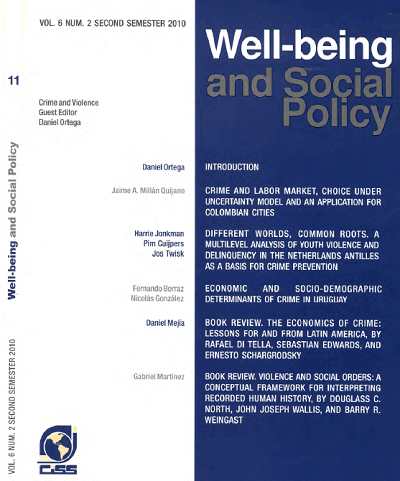
|
|
|
|

|
|
Socio-economic determinants and inequalities in childhood malnutrition in Sri Lanka
Despite countless initiatives to alleviate malnutrition over the years, it affects hundreds of thousands of children in Sri Lanka. Understanding the determinants of malnutrition and their contribution to socio-economic inequality in malnutrition is essential in targeting specific socio-economic groups to improve their nutrition levels. This study attempts to identify the socio-economic...
|
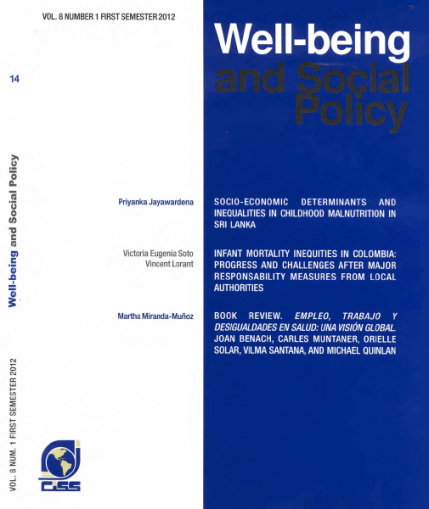
|
|
|
|

|
|
Social security pensions and retirement decisions in Mexico
Using Mexican cohort data for 1991-2000 this article examines the relationship between retirement decisions —the transition from work to labor market inactivity— and social security (contributive) pensions in less developed countries. The available large time series also makes possible to examine how a financial crisis that took place in 1995 has affected retirement incentives. In most Latin...
|

|
|
|
|

|
|
Promised and actual benefits in mexican social security fot rhe transtion generation
Este artículo presenta un conjunto de mediciones de los costos y beneficios reales del plan general de retiro por jubilación proporcionado a los ciudadanos por parte del Sistema Mexicano de Pensiones (SMP), que son necesarias para evaluar las decisiones de los trabajadores en cuanto a la contribución a la seguridad social (es decir, trabajar en el sector formal) y al retiro. El SMP ofrece dos...
|

|
|
|
|

|
|
A simple poverty scorecard for Mexico
This study uses Mexico's 2008 National Household Survey of Income and Expenditure to I construct an easy-to-use scorecard that estimates the likelihood that a household has income below a given poverty line. The scorecard uses ten simple indicators that field workers can quickly collect and verify. Poverty scores can be computed on paper in the field in about five to ten minutes. The scorecard's...
|
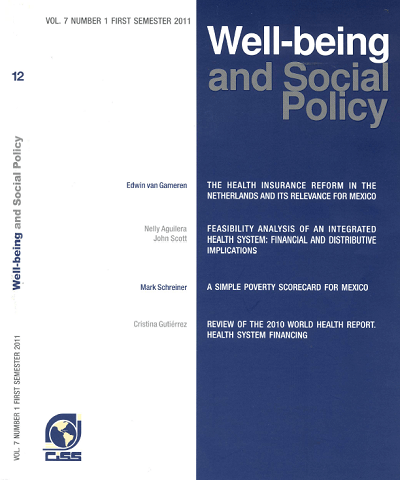
|
|
|
|

|
|
Feasibility analysis of an integrated health system: financial and distributive implications
The document presents spending projections and projections of the distributive incidence for an Integrated Health System under three basic scenarios: status quo, a two pillar scheme (financed through general taxes and private spending) and a three pillar scheme (financed through general taxes, social security contributions and private spending). By presenting these simulations, the study enhances...
|
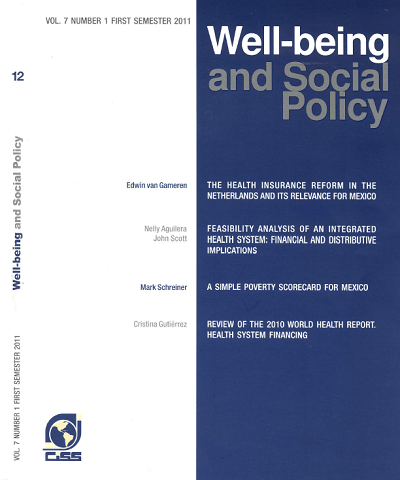
|
|
|
|

|
|
The health insurance reform in the Netherlands and its relevance for Mexico
Alrededor del mundo se observan dos versiones de la organización de los seguros de salud; la seguridad social basada en el empleo, y los servicios nacionales de salud. En Latinoamérica regularmente se usa la primera, pero se está lejos de lograr la cobertura universal. En los Países Bajos encontramos una peculiar mezcla de obligaciones públicas y responsabilidades privadas. La cobertura universal...
|

|
|
|
|

|
|
Book review. The economics of crime: lessons for and from Latina America, by Rafael Di Tella, Sebastian Edwards, and Ernesto Schargrodsky
The Economics of Crime: Lessons for and from Latin America makes an important contribution to the study of crime and violence in Latin America and to the debate about what works for reducing crime (and at what cost?). As the title of the book correctly suggests, the book brings together contributions from Latin American economists on the determinants and consequences of crime, as well as...
|
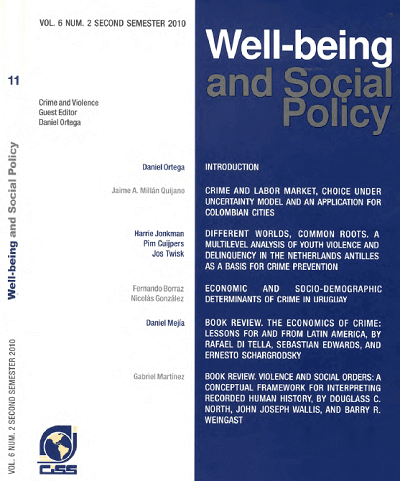
|
|
|
|

|
|
Book review. Empleo, trabajo y desigualdades en salud: una visión global. Joan Benach, Charles Muntaner, Orielle Solar, Vilma Santana y Michael Quinlan
This is a stimulating book which explores the relationship between employment conditions and health outcomes. The authors provide a conceptual framework to illustrate the channels through which health outcomes are determined and affected; this framework includes individual and aggregate variables, such as the economic, political and environmental conditions. The book also includes case studies...
|
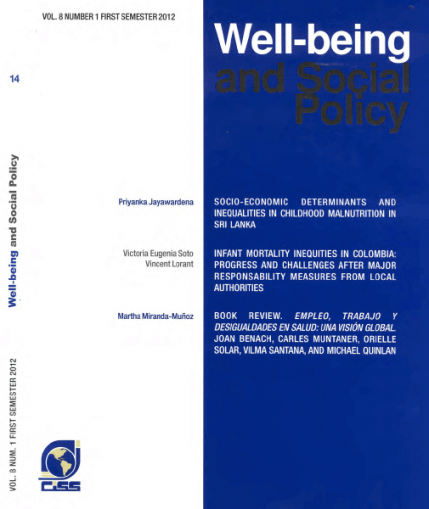
|
|
|
|

|
|
Different worlds, common roots a multilevel analysis of youth violence and delinquency in the netherlands antilles as a basis for crime prevention
Most research on the prevalence, determinants, and variations of violence and delinquency among youngsters is conducted in Western societies. This multilevel study is set in the Netherlands Antilles (NA) and aims to build up prognostic multilevel models as a basis for targeted crime prevention in a non-western area. Data were collected from a sample of adolescente in the NA. Non-hierarchical and...
|
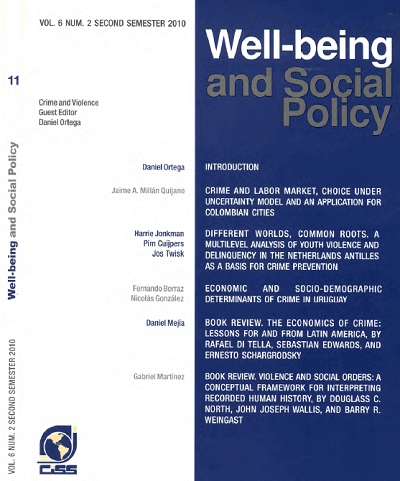
|
|
|
|

|
|
Crime and labor market, choice under uncertainty model and an application for colombian cities
Este trabajo ofrece un modelo para determinar la función de oferta del crimen con base en la teoría de la elección en condiciones de incertidumbre. Con base en el problema de un agente que maximiza su utilidad sujeto a las restricciones del mercado legal e ilegal, este estudio intenta explicar la oferta de la delincuencia como función de la distribución de los salarios y el equivalente cierto de...
|
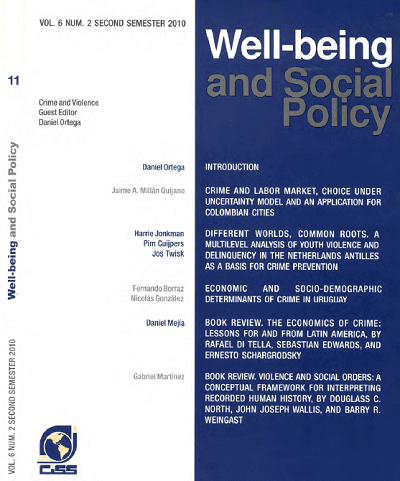
|
|
|
|

|
|
Introduction (On the studies presented at the International Conference on "Delinquency and Violence in Latin America and the Caribbean")
Crime has become the leading concern for citizens of the region and has been pushed to the forefront of the international policy agenda; what is more, the combination of very few success stories and abundant failures in curbing crime and violence has underscored how thin our understanding is and the difficulty of designing and implementing an effective strategy at the local level. This issue...
|

|
|
|
|

|
|
Los espacios públicos en México como detonadores de la cohesión social: un enfoque de modelado estructural
Esta investigación evaluó los efectos de varios factores contextuales (por ejemplo, la inseguridad vecinal, la evaluación de los espacios públicos, la infraestructura, los comportamientos de bajo riesgo) en materia de cohesión social y de satisfacción residencial, en el contexto de individuos de situación socioeconómica baja y media-baja que se encuentran cerca de espacios públicos (parques e...
|
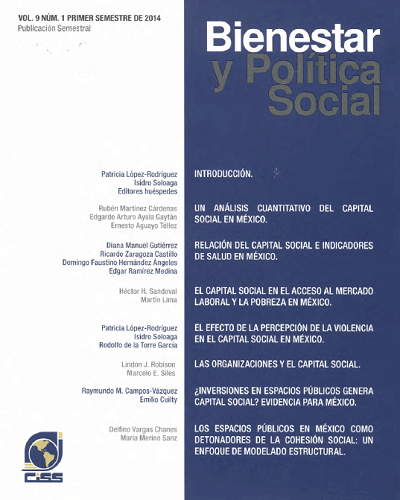
|
|
|
|

|
|
¿Inversiones en espacios públicos para generar capital social? Evidencia para México
La formación de capital social es de suma importancia para países en vías de desarrollo. El presente trabajo investiga los efectos en rescates de espacios públicos en zonas marginadas de México. Los efectos son estimados mediante balanceo en los puntajes de propensión. Nos enfocamos en los resultados de percepción de seguridad, asistencia y capital social. Se encontró que debido a la intervención...
|

|
|
|
|

|
|
Las organizaciones y el capital social
Una organización es un grupo de personas que reúnan requisitos de membresía establecidos y cuya forma y función son generalmente reconocidos. Los requisitos para ser miembro de una organización pueden basarse en rasgos heredados o adquiridos. Las organizaciones existen porque proporcionan un entorno en el que los miembros de rasgos similares pueden satisfacer sus necesidades físicas y...
|

|
|
|
|

|
|
El efecto de la percepción de la violencia en el capital social en México
El incremento en la violencia que presenta México con consecuencias en la ruptura del tejido social y en variables económicas clave nos llevan a analizar el efecto del cambio en la percepción de la violencia en el cambio en el capital social –como asociativismo- entre el 2006 y el 2011, periodo en el que se inició la política contra la violencia y el crimen organizado en México (2006-2012). Se...
|

|
|
|
|

|
|
Infantil mortality inequities in Colombia: Progress and challenges after major responsability measures from local authorities
This paper aims to analyse the space and time distribution of the infant mortality rate (IMR) at municipality level in Colombia before and after conferring greater responsibilities to the municipalities for the administration of the local health care systems. Using special econometrics, we find that there is a geographical concentration of IMR persisting over time and defining two groups of...
|

|
|
|
|

|
|
Introduction (On the issues addressed by this issue of the journal)
Micro and small-sized enterprises (MSE) have a central role in economic development in Latin America given their large contribution to employment generation, their share in the total number of firms and, to a lesser extent, their contribution to gross domestic product. Yet, their production is mainly oriented to the domestic market and they are characterized by an increasing productivity gap with...
|
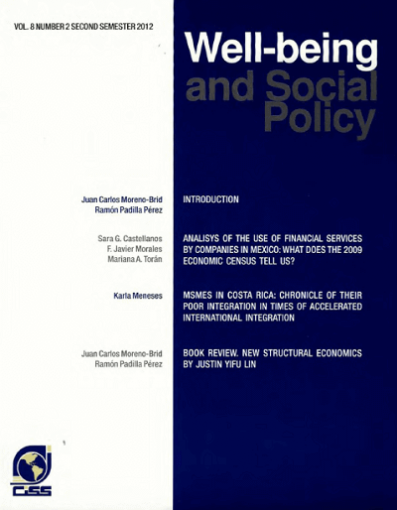
|
|
|
|

|
|
Un análisis cuantitativo del capital social en México
Se ha relacionado el capital social a la eficiencia en los mercados (Arrow, 1972), al refuerzo del contrato (Durlauf y Fafchamps, 2004) y en general al desarrollo y bienestar (Keefer y Knack 1997; Putnam 2000; Knack y Zak 2003). En el presente trabajo hemos investigado los determinantes del capital social empíricamente, centrándose en tres medidas comunes aproximadas de este: dos ligadas a la...
|

|
|
|
|
|